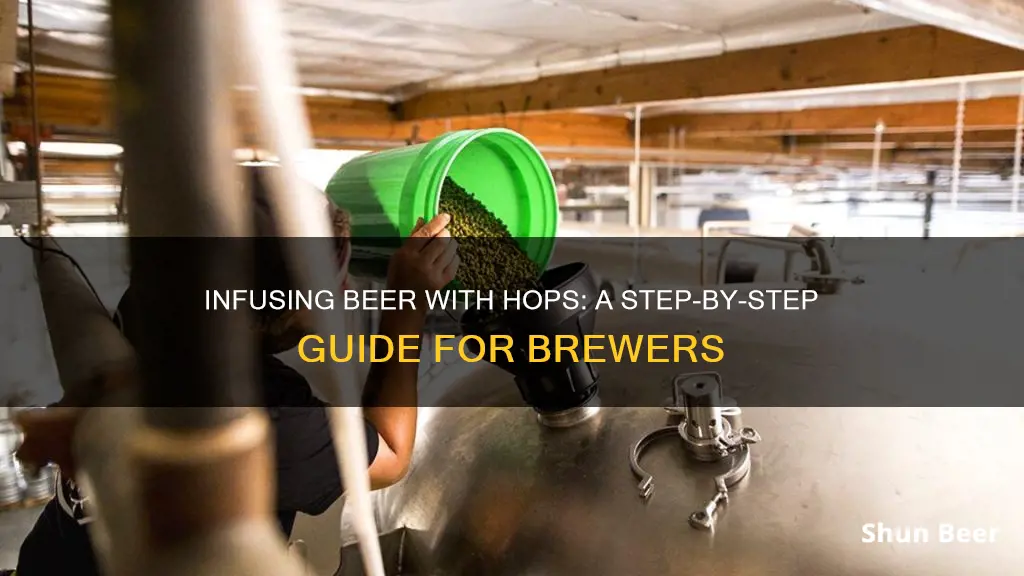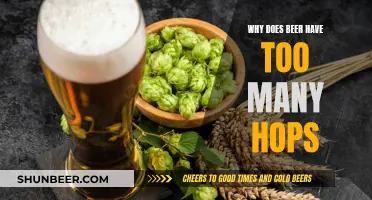
Hops are an essential ingredient in beer, adding bitterness, flavour, and aroma, as well as acting as a natural preservative. The hop plant contains three main components: alpha acids, beta acids, and essential oils. The type of hop, the amount used, and the way in which the hops are used in the beer-making process all play a significant role in determining the final product. This article will explore the different methods for infusing beer with hops, including dry hopping, hops tea, and using a French press.
| Characteristics | Values |
|---|---|
| When to introduce hops | For bitterness, hops should be introduced early in the boil (at least 30 minutes before flame off). For aroma, the best time to introduce hops is in the last 10-15 minutes before the beginning of the wort cool. |
| Type of hops | Leaf or cone form is preferred over pellets, which disintegrate into powder and hamper clarity. |
| Timing of infusion | Infuse hops 2 weeks before bottling to allow for maximum extraction and to let all the complex flavors and aromas blend well. |
| Bagging hops | Use a bag weighed down with a glass marble to prevent a floating leaf, which can be a perfect harbor for unwanted microbes (mold). |
| Amount of hops | Start with 1 oz. of hops per 5 gallons of beer. |
| Hop preservation | Hops are anti-microbial in nature, so adding them without sterilizing them first is acceptable. |
| Hop particle reduction | Allow hops to remain within the secondary fermenter for 10-14 days. The hops may break down during this time, allowing particles to sink to the bottom and creating a clearer beer. |
| Hop containment | Contain hops with a nylon mesh bag or a muslin bag. |
What You'll Learn

When to introduce hops in the brewing process
Hops are typically added to the wort in three stages during the boil: bittering, flavour, and aroma. However, not all beers will have three additions; some may have only one, while others may have up to five or six.
Bittering hops are added once the wort has been collected in the kettle and a rolling boil has been achieved. They are usually boiled for 60 minutes, but some recipes call for as little as 30 minutes. All beers have some bittering hops to balance the sweetness of the malt. The longer bittering hops are boiled, the more alpha acids are released, increasing the bitterness of the beer.
Flavoring hops are added with between 15 and 30 minutes remaining in the boil. During this time frame, very little bitterness will be extracted from the hops, but the crisp hoppy flavour will be imparted.
Aroma hops are added during the last 5 minutes of the boil or at flame out when the kettle is removed from the heat. The hop oils responsible for aroma are extremely volatile and will be driven off in the steam of the boil almost immediately, so aroma hops must not be boiled for long.
The timing of hop additions is crucial, as the longer hops are exposed to heat, and the higher the temperature, the more likely it is that bitterness will be imparted and flavour lost. Therefore, to achieve a balance of bitterness and flavour, hops are added at different stages of the brewing process.
Genesee Bock Beer: Hoppy or Not?
You may want to see also

The importance of the type of hops used
The type of hops used is of paramount importance when infusing beer with hops. Hops are the cone-shaped flowers of the female hops plant, Humulus lupulus, and they contain resins and essential oils found in the lupulin glands of the hop cones. These resins and oils impart bitterness, flavour, and stability to the finished beer.
There are three main categories of hops used in brewing: bittering, finishing, and dual-purpose. Bittering hops have high alpha acid levels and are added early in the boil to extract maximum bitterness. Finishing hops, on the other hand, have high aroma levels and are added later in the process, emphasising their aromatics and imparting less bitterness. Dual-purpose hops are a combination of both bittering and finishing hops.
The choice of hops depends on the desired style and flavour profile of the beer. For example, IPA and Pale Ale brewers might opt for hops with a flowery, spicy, and citrus-like quality, while brewers of American Ales, Amber beers, and IPA may choose hops that add tropical fruit and citrus characters. Lambic hops are used in lambics due to their low bitterness, and Saaz hops, with their aromatic blend and earthy flavours, are commonly used in lagers and pilsners.
The timing of when the hops are added during the brewing process is also crucial. Adding hops early in the boil will result in higher bitterness but will hamper the ability to retain aromas. Conversely, adding hops later in the process will create a stronger hoppy aroma. Techniques such as dry hopping, where hops are added to the fermenter, and wet hopping, where fresh, un-dried hops are used within 24 hours of being harvested, are also used to impart specific flavour and aroma profiles.
Dry Hopping Beer: Timing and Techniques for Flavorful Brews
You may want to see also

The role of hops in beer
Hops are one of four essential ingredients in beer (alongside barley, yeast, and water). They are the cone-shaped flowers of the female hops plant, Humulus lupulus, a cousin of the cannabis plant. Hops contain acids and oils that impart bitterness, flavour, and stability to the finished beer.
Hops are typically added to the boil stage of brewing. It takes around an hour to unleash the "alpha" acids that bitter and balance the sweetness of the malt. Hops are most often associated with bitterness, but they can also be used to add flavour. Depending on the style of beer being brewed, hops may be added later in the boil, as aromatic oils are destroyed in a long boiling process. Beers can also be dry-hopped (added during fermentation) or fresh-hopped (when just-picked hops are brought straight to the brewery).
Hops are responsible for the bitter taste of beer (along with the alcohol). They create soluble alpha and beta acids when boiled, which become part of the brew. The flavour comes from the unique blend of oils present in each variety – extra hops can be added after boiling to add flavour without bitterness.
Hops also act as a preservative, extending the beer's shelf life by natural means. The higher the beer's hop content, the longer its shelf life.
Apple Cider Beer: Hops or No Hops?
You may want to see also

Dry hopping vs. adding hops during the boil
Dry hopping and adding hops during the boil are two different methods of infusing hops into beer. Both techniques have their own advantages and can be used to achieve different results in terms of bitterness, flavour, and aroma.
Dry Hopping
Dry hopping is the process of adding hops to beer either during or after fermentation. This technique is often used for IPAs and other hoppy beer styles. Since there is no heating involved in dry hopping, the bitterness level remains low. Instead, the hoppy aromas are fully extracted in the presence of alcohol, which acts as a solvent. Dry hopping is typically done 2 weeks prior to bottling to allow for maximum extraction and to ensure that all the complex flavours and aromas blend well. It is important to note that dry hopping can easily overpower your beer, so caution is necessary.
Adding Hops During the Boil
Adding hops during the boil, on the other hand, can be done at different stages to achieve different results. Bittering hops are added early in the boil, usually for at least 30 minutes, to extract the resins and obtain maximum bitterness. However, this can hamper your ability to retain aromas. For better aroma retention, aromatic hops are added during the last 10-15 minutes of the boil or at flameout, which is when the kettle is removed from the heat. This allows for an optimal mix of resin extraction and aroma infusion.
Comparison
While dry hopping is excellent for extracting aromas, it does not contribute much to bitterness. On the other hand, adding hops during the boil can provide both bitterness and flavour, depending on when they are added. However, boiling hops can result in the loss of volatile aromatic hop oils, which is a disadvantage compared to dry hopping. Ultimately, both techniques have their merits, and brewers can experiment with each to achieve their desired balance of bitterness, flavour, and aroma.
Hops in Beer and Vinegar: What's the Connection?
You may want to see also

Using a French press to infuse beer with hops
Firstly, you will need to get your hands on a French press. These are readily available online or in stores, with prices starting at around $15 for a basic model. The French press was invented in 1929 for brewing coffee, but it has since found alternative uses, such as infusing beer. It typically consists of a large glass beaker, a lid, and a plunger with a filter at the bottom.
Once you have your French press, the fun begins. You can use any style of craft beer, but stouts are recommended as they tend to hold up better during the infusion process. The first step is to pour about half to three-quarters of your beer into the French press and refrigerate the rest for later.
Next, it's time to add your ingredients. For this guide, we will focus on hops, but feel free to experiment with other ingredients like fruits, spices, or even cocoa nibs. Add as much or as little hops as you want, depending on your desired intensity. Place the top on the French press without depressing the plunger and put it in the refrigerator for at least 30 minutes.
After chilling, remove the French press from the refrigerator and slowly press down the plunger. Return the French press to the refrigerator for at least another 30 minutes to continue the infusion process.
Finally, pour your infused beer into a glass and give it a taste. Depending on the flavour, you may want to add some of the base beer you saved earlier to adjust the intensity. Keep in mind that the beer will lose most of its carbonation during the infusion process, so it's best to use darker beers that can withstand this change. If you want to use a lighter beer, shorten the infusion time to just a few minutes to prevent it from going flat.
With this method, you can create endless flavour combinations and discover new favourites. So get creative, experiment, and have fun exploring the world of craft beer infusions!
Gose Beer and Hops: An Unlikely Friendship
You may want to see also
Frequently asked questions
There are several ways to infuse hops into beer, including dry hopping, using a French press, and hops tea. Dry hopping involves adding hops directly to the beer post-fermentation, while a French press or hops tea can be used to infuse hops into the beer before consumption.
The timing of hop addition depends on the desired effect. For maximum bitterness, hops should be introduced early in the boil, while aromatic hops are typically added during the last 10-15 minutes before the beginning of the wort cool to retain their aromas.
The type of hops used depends on the desired flavour and aroma. Hops high in alpha acids, such as Chinook, Columbus, and Simcoe, are ideal for bittering and are added during the beginning of the boil. Hops low in alpha acids, such as Cascade, Fuggle, and Kent Golding, are effective for adding flavour and aroma and are typically added later in the boil or during dry hopping.
The amount of hops used will depend on the desired intensity of flavour and aroma. When dry hopping, it is recommended to start with 1 oz. of hops per 5 gallons of beer. For hops tea, 1 ounce of hops per quart of water is typically sufficient.







